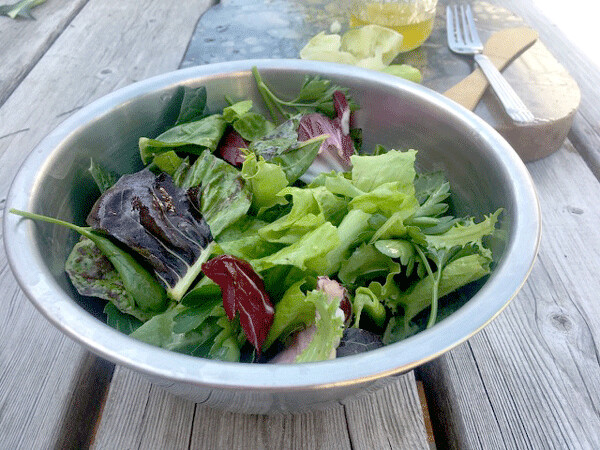How to eat raw leaves

When it comes to eating healthy, the importance of a good vinaigrette cannot be overstated. Among the many competing nutritional paradigms to believe, raw leaves are never shunned.
None of the diets that focus on carbohydrate, fat and protein have any problem with raw leaves. Nor do clans like Paleo or vegan, or fads with names too silly to print. Even Dr. Atkins ate leaves.
Raw greens deliver a broader spectrum of nutrients than cooked, because raw greens are alive, with functioning enzymes and uncooked proteins. But cooked greens are really good too.
The most negative thing that anybody has ever said about raw leaves is they don't care to eat them. And cooks respond to this objection by adding evermore non-leafy materials. That's why I've been distinguishing "raw leaves and greens," rather than just saying "salad," which has become a code word for "whatever you really want to eat, atop plant parts." Croutons, dried fruit, extra protein and other toppings are weighing down the salads of America, and the raw leaves are getting suffocated and left behind.
It's one thing to avoid adding a bunch of unnecessary business to your raw leaves, but making them taste good is another matter. Bottled salad dressing can be as disappointing as it is expensive, and can be so rich that if you were to eat a big salad, which you should, then you would be consuming a lot of rich dressing. Even the fancy ones can have cheap ingredients, or empty oils like soy, canola, corn or safflower. When you dress from a bottle, you dress with stabilizers, preservatives, and sugars like maltodextrin that don't sound like sugar but are just as bad if not worse. It makes all the sense in the world to spend your money on good ingredients. Mostly, this means good olive oil.
There are arguments to be made for some other oils in certain situations, for walnut, sesame or pumpkin seed oils, and many others. But the flavorless, empty oils mentioned above don't add anything but fatty acid chains. Instead, get a good olive oil and hit it hard. Good olive oil adds its own bouquet of bitter and buttery flavors, complimenting those of the leaves themselves.
A good vinaigrette often sounds like a great idea, but in practice, mixing your own oil and vinegar can result in a less satisfying salad than had you just dumped some bottled Italian on your foliage.
A proper homemade dressing won't upstage your leaves or fill you up like bottled dressing often does. And you can make it with the finest ingredients available and still save money, without the assistance of brewer's yeast, guar gum or sodium clusterf#cktate.
Here are two easy vinaigrette recipes that will turn a pile of leaves into something more satisfying. These recipes need to be stirred well and tossed into the salad. You can't leave it in a bottle on the table and let people dress their own, because it will have separated-unless you have a fancy-fangled vinaigrette mixing stirring bottle thing.
Alternatively, you can dip your leaves into the dressing, like my wife does. She created these recipes, so she should know. She'll toss a vinaigrette into a salad if we are having company, otherwise she dips. We all do, now. Mostly radicchio wedges, but also romaine and other crispy salad greens. If you dip, use less oil at first, so you don't dip through a thick layer of oil. Keeping a thin layer of oil on top, add more as necessary.
Her Vinaigrettes use the following ingredients
Extra Virgin Olive Oil It has to be good stuff, at a price where you can afford to dump it on. My favorite is California Ranch. It's cheaper than almost any so-called specialty oils, and superior. Where I shop, Lucini is a comparable Italian option. A fine XVOO will offer its own range of bitterness, and form a bond with the bitterness of the greenery.
Four kinds of acid. Vinegar is the back bone of a vinaigrette. You can't even say "vinaigrette" without saying "vinegar." Diversity in the acid department brings complexity, depth of flavor and mystery to a vinaigrette. For these recipes we'll need apple cider vinegar, balsamic vinegar, and white balsamic vinegar (AKA White Modena Vinegar and White Italian Condiment. If this can't can't be found, seek another dry vinegar made from white grapes, like sherry or Champagne vinegar. Alternatively, rice vinegar.) The fourth acid is lime or lemon juice.
Sodium. Salt is the most overlooked and easiest pitfall for the novice vinaigrette-maker to remedy. These two recipes are distinguished by their use of soy sauce or salt crystals.
At the risk of sounding like one of those Mediterranean diet guys, olives and feta do go great with both of these salads. Also, don't forget to cut the greens into bite-sized chunks.
The Soy Sauce Vinaigrette is good for strong-tasting leaves. It has a strong flavor of its own, smooth and sweet enough to pacify even the bitterest of greens. Even dandelion greens will taste sweet in this salty dressing.
2 parts XVOO
1 part soy sauce
1 part vinegar (the vinegar part being an equal mix of apple cider, balsamic and white balsamic)
Mix well with a fork or a whisk. Test by dipping a leaf. Adjust the proportions to taste. Toss into a salad and go.
The Salt Vinaigrette is a delicate dressing, sleeker than the soy sauce vinaigrette, and good for mild greens, or greens you know you like. It's for your best greens, in other words, the ones you want to savor and celebrate.
One serving:
(Use the same proportions for larger batches)
2 tablespoons VXOO
1 tablespoon freshly squeezed lemon or lime juice
1 tablespoon white balsamic
¼ teaspoon salt
Mix the dressing well. Pour into the salad, toss, and serve.
